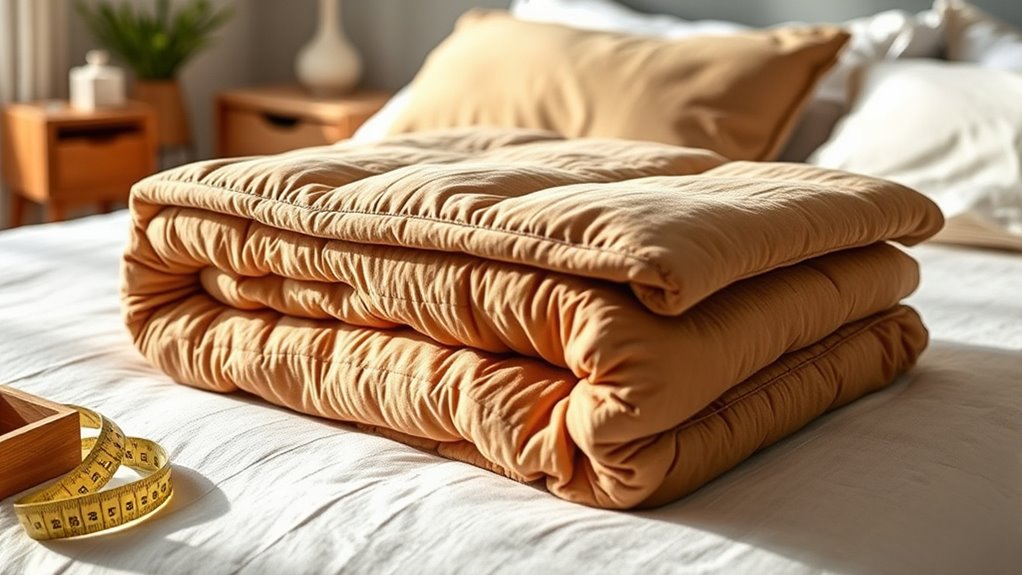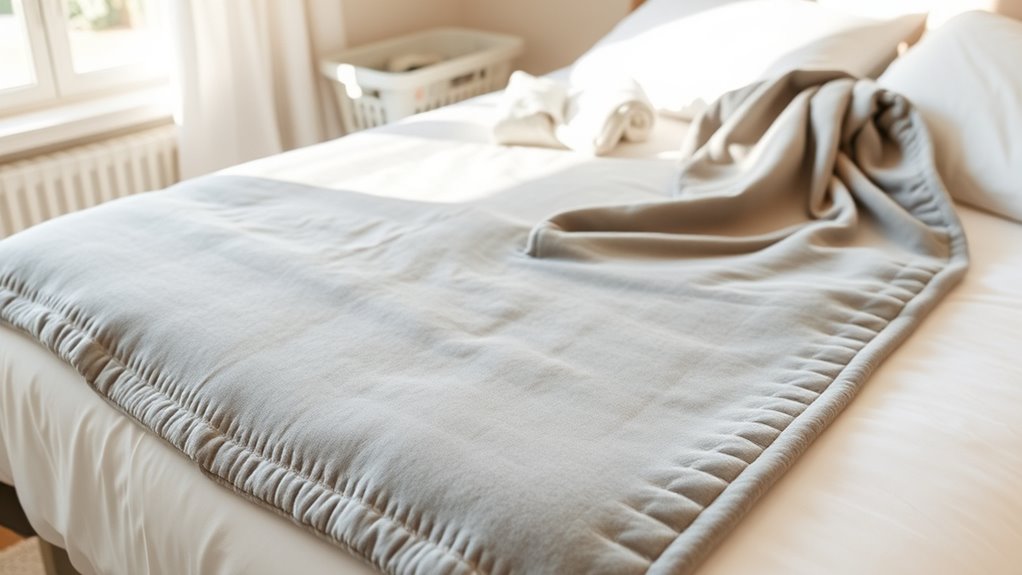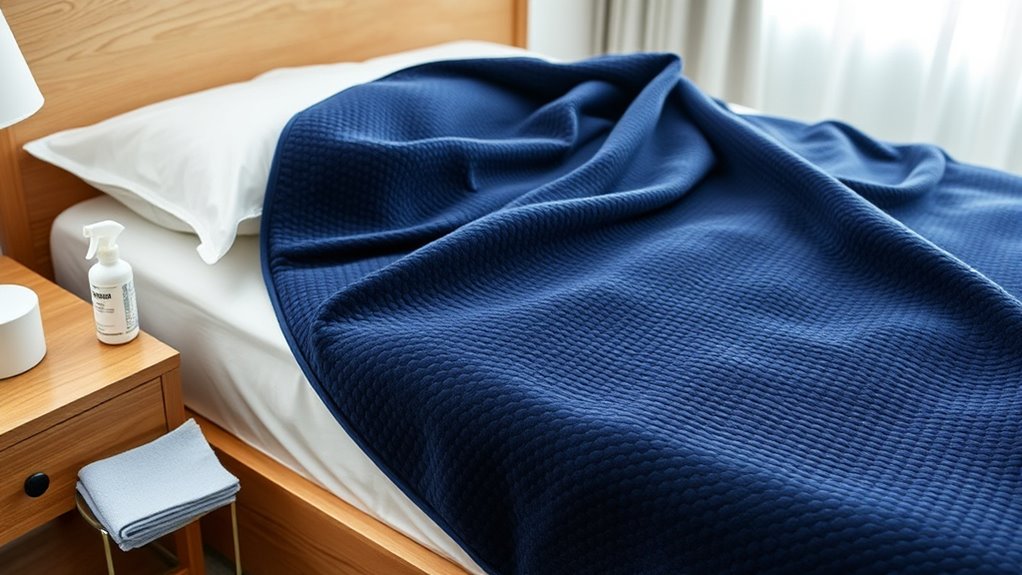To use your weighted blanket safely and effectively, choose one that’s about 10% of your body weight and lay it evenly across your shoulders and torso. Regularly adjust its placement for comfort, and avoid wrapping it too tightly. Keep it clean by washing gently and storing in a cool, dry place. Watch for signs of wear and tear, and replace it when necessary—continue exploring to discover more tips for proper care and safety.
Key Takeaways
- Choose a blanket that weighs about 10% of your body weight for safety and comfort.
- Use breathable fabrics like cotton or bamboo to enhance comfort and temperature regulation.
- Regularly inspect seams and fabric for wear, and clean with gentle cycles to maintain durability.
- Ensure even weight distribution by adjusting placement and avoiding bunching during use.
- Store the blanket properly in a cool, dry, and breathable container to prolong its lifespan.
Choosing the Right Weight and Size

Choosing the right weight and size for your weighted blanket is essential for comfort and effectiveness. Your weight selection should typically be about 10% of your body weight, ensuring the blanket provides gentle, even pressure without feeling too heavy. Size considerations are just as important; your blanket should cover your body comfortably without hanging over the edges, which can cause discomfort or restrict movement. If the blanket is too small, you won’t experience the full benefits of deep pressure stimulation. Conversely, a blanket that’s too large may feel cumbersome or overwhelming. Take time to measure your bed and personal preferences to find a size that fits well and feels cozy. Proper weight and size help maximize relaxation and improve your overall sleep quality. Additionally, selecting a comfortable material can enhance your sleep experience and encourage regular use.
Properly Placing and Using Your Blanket

Once you’ve selected the right weight and size for your blanket, it’s important to position it correctly to maximize comfort and benefits. Lay it evenly across your body, ensuring it covers your shoulders and torso. To enhance visual appeal, choose a blanket with decorative patterns that match your room decor. Fabric selection matters: opt for breathable materials like cotton or bamboo for comfort, especially during warmer months. Keep the blanket smooth and avoid bunching, which can cause discomfort. Use the table below to help with placement and style considerations:
| Feature | Tip |
|---|---|
| Decorative Patterns | Select patterns that complement your space |
| Fabric Selection | Prioritize breathable, soft fabrics |
| Placement | Cover shoulders and torso evenly |
Additionally, proper placement can improve color accuracy and overall visual harmony in your space.
How to Safely Use a Weighted Blanket

To use a weighted blanket safely, it’s essential to start with the right size and weight for your body. Choose a blanket that is about 10% of your body weight for ideal comfort and safety. Once you’re under the blanket, focus on breathing techniques, such as deep, slow breaths, to stay relaxed and prevent feeling overwhelmed. Maintain a comfortable sleep environment—dim lighting, cool temperature, and minimal noise—to promote restful sleep. Avoid wrapping the blanket too tightly or using it if you feel uncomfortable or unable to breathe easily. Always listen to your body, and if you experience discomfort, remove the blanket immediately. Proper use guarantees safety while maximizing the calming benefits of your weighted blanket. Additionally, ensuring your sleep environment is free of humidity and heat sources can help preserve the blanket’s integrity and comfort.
Regular Cleaning and Maintenance Tips

To keep your weighted blanket fresh and in good shape, it’s important to follow careful washing instructions. Make sure you know the recommended cleaning methods and avoid damaging the fabric or stuffing. Proper storage also helps maintain its quality and longevity over time. Additionally, using appropriate maintenance techniques can extend the lifespan of your blanket and ensure it remains comfortable and safe to use.
Careful Washing Instructions
Regular cleaning and maintenance are essential to keep your weighted blanket in good condition and guarantee its longevity. When washing, avoid fabric softeners, as they can damage the fabric and filling over time. Use a gentle cycle with cold water to prevent shrinking or warping. For drying, opt for air drying or use a low heat setting if your dryer allows. Be cautious with drying techniques; high heat can damage the fabric and affect the weight distribution. If your blanket is too heavy for a standard dryer, consider hanging it in a well-ventilated area. Always check the care label beforehand for specific instructions. Proper washing and drying ensure your blanket stays soft, evenly weighted, and durable for years to come.
Proper Storage Practices
Proper storage is key to maintaining your weighted blanket’s shape and longevity. When not in use, store it in a cool, dry place away from direct sunlight to guarantee storage safety. For seasonal storage, fold the blanket neatly and place it in a breathable storage bag or container to prevent dust and moisture buildup. Avoid plastic bags that can trap humidity. Keep it flat or loosely rolled to prevent creases and damage. Consider using a dedicated linen closet or closet shelf. Regularly check stored blankets for any signs of moisture or pests. Using appropriate storage methods can help preserve the integrity of your blanket and prevent damage caused by improper storage. Remember, proper storage practices extend your blanket’s lifespan and keep it ready for use whenever needed. Proper seasonal storage and safety precautions are essential to preserving your blanket’s quality over time.
Storage Recommendations When Not in Use

When you’re not using your weighted blanket, storing it properly helps maintain its shape and longevity. For seasonal storage, make sure the blanket is clean and completely dry before folding it gently and placing it in a breathable storage bag or cotton pillowcase. Avoid plastic containers or sealed bags, as they can trap moisture and cause mold. If you’re traveling, follow simple travel tips: fold the blanket neatly and keep it in a sturdy bag or suitcase to prevent damage. Avoid stuffing it into tight spaces or heavy compression, which can damage the filling. Store your blanket in a cool, dry place away from direct sunlight to prevent fabric degradation. Proper storage not only preserves the blanket’s quality but also makes it easy to find and use when needed.
Troubleshooting Common Issues

Even with proper storage, you might encounter some common issues with your weighted blanket. If the fabric feels uneven or clumps, check for fabrics compatibility and verify the filling is evenly distributed. Allergies can also cause discomfort—if you notice skin irritation, confirm that your blanket’s materials are allergy considerations suitable for you. To troubleshoot, consider the following:
Check fabric compatibility and ensure filling is evenly distributed to avoid clumping and discomfort.
- Wash the blanket according to care instructions to remove dust or allergens
- Inspect seams for tears or loose stitching
- Ensure the weight is appropriate for your size and needs
- Confirm the fabric type is compatible with your skin and allergies
- Adjust or replace the cover if it becomes worn or uncomfortable
- Dream symbols can sometimes provide insights into underlying issues or emotional states that might be affecting your comfort or sleep quality.
Addressing these issues promptly keeps your blanket comfortable and safe to use.
Extending the Life of Your Weighted Blanket

To keep your weighted blanket in ideal condition, regular maintenance is essential. Start by choosing fabric materials that are durable and easy to clean, such as cotton or microfiber, to withstand frequent washes. When selecting color choices, opt for darker shades or patterns that hide stains and fading over time. Always follow the care instructions provided by the manufacturer, washing your blanket in cold water on a gentle cycle to prevent fabric wear. Avoid harsh detergents and bleach, which can damage the fabric and filling. To prevent uneven weight distribution, regularly shake or redistribute the internal weights. Storing your blanket properly, folded in a cool, dry place, also helps maintain its appearance and integrity. Proper care extends its lifespan and keeps it comfortable for years. Additionally, being aware of fabric durability can help you choose the best materials for long-term use.
When to Replace Your Weighted Blanket

Your weighted blanket will eventually need replacing once it shows signs of wear or diminished effectiveness. Over time, durability factors like frequent washing, use, and material degradation can weaken the fabric and fillings. Keep an eye out for these indicators:
Replace your weighted blanket when it shows wear or loses effectiveness for continued comfort and safety.
- Loose or torn fabric
- Clumping or shifting of weights
- Persistent odors despite cleaning
- Reduced comfort or heaviness
- Visible signs of fabric thinning
Material degradation can compromise the blanket’s safety and effectiveness, so don’t overlook these signs. If your blanket no longer provides the intended pressure or feels uncomfortable, it’s time to think about a replacement. Proper care extends its lifespan, but eventually, replacing it ensures you continue to enjoy the benefits safely and comfortably. Regular inspection of the materials used in your blanket can help identify early signs of wear before they become a safety concern.
Frequently Asked Questions
Can Weighted Blankets Be Used by Children Safely?
You might wonder if weighted blankets are safe for children. To guarantee child safety, always follow weight guidelines, typically choosing a blanket that’s about 10% of your child’s body weight. Supervise young children during use, and consult with a pediatrician if you’re unsure. Proper use minimizes risks, and adhering to safety tips helps your child enjoy the comfort and benefits of a weighted blanket safely.
Are There Specific Fabrics Recommended for Sensitive Skin?
Think of fabric choices as a gentle whisper against your skin; for sensitive skin, soft, natural fabrics like cotton or bamboo are your best allies. These materials act like a soothing lullaby, reducing irritation and providing comfort. Always check labels and opt for breathable, hypoallergenic options. By choosing the right fabric, you create a cozy haven that respects your skin sensitivity, turning your weighted blanket into a gentle embrace rather than a harsh reminder.
How Do I Prevent My Blanket From Shifting During Sleep?
To prevent your blanket from shifting during sleep, guarantee the weight is evenly distributed across your body. Using non-slip mats underneath the blanket can also help keep it in place on your bed or mattress. Adjust the blanket regularly to maintain even weight distribution, and consider choosing a size that fits your bed snugly. These steps will help you stay comfortable and secure throughout the night.
Is It Safe to Use a Weighted Blanket With Pets?
Using a weighted blanket with pets can be safe if you prioritize pet safety and allergy concerns. You should guarantee your pet can easily move away if needed and avoid covering their face. Keep the blanket clean to prevent allergen buildup, and choose a lightweight option if your pet has respiratory issues. Always supervise your pet during use and consult your vet if you’re unsure about specific health concerns.
Can I Wash My Weighted Blanket in a Standard Washing Machine?
You can usually machine wash your weighted blanket, but check the care label first. Use a gentle cycle and cold water to safeguard the fabric’s durability. Avoid harsh detergents, and consider washing it separately to prevent damage. Machine washing helps keep your blanket clean and fresh, but always follow manufacturer instructions to guarantee the fabric stays in good condition and to prolong its lifespan.
Conclusion
Taking care of your weighted blanket isn’t just about maintenance—it’s about enhancing your comfort and well-being. Some say weighted blankets can even improve sleep quality over time, and evidence suggests consistent proper care can extend their lifespan. So, follow these tips, stay attentive to your blanket’s needs, and enjoy the cozy benefits. After all, a well-cared-for blanket isn’t just a comfort—it’s an investment in your restful nights.








